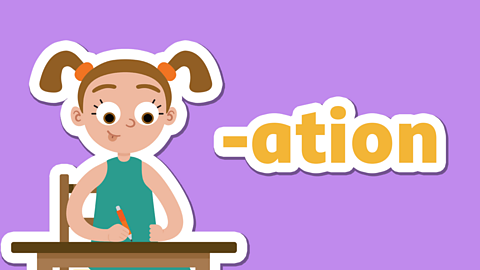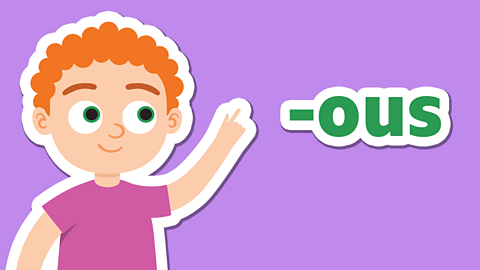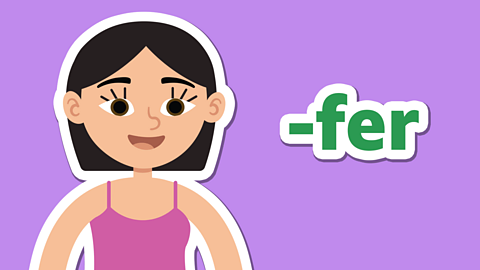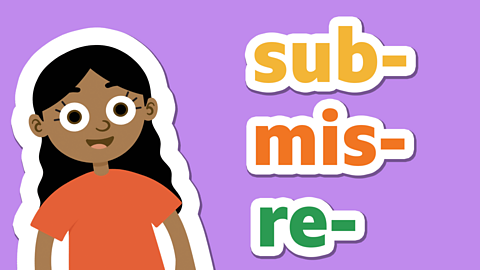What is a suffix?

A suffix is a letter or group of letters that goes on the end of a word and changes its meaning.
Adding the suffix -ing to the end of a noun can change it into a verb.
For example:
garden + -ing â gardening
Adding the suffix -ed to a verb can form the past tense of that verb.
For example:
jump + -ed â jumped

Watch: Suffixes -ing and -ed
Watch this clip to learn more about the suffixes '-ing' and '-ed'.
When you are writing, the verbs you use show whether something has already happened, is happening now or will happen in the future.
Watch: Using suffixes to show tenses
Watch the following Teacher Talk with Ms. Williams to learn more about using suffixes to show past, present and future tense.
Learn about using suffixes to show past, present and future tense with Ms. Williams
Past tense

The past tense is used for things that have already happened.
Past tense verbs often end in -ed.
For example:
I walked to the shop.
However, not all past tenses are written like this as there are exceptions which need to be learned separately.
For example:
I bent down to pick up a penny.
The correct past tense of the verb to bend is 'bent' not 'bended'.
She swam three lengths in the swimming pool.
'Swam' is the correct past tense of the verb to swim, not 'swimmed'.

Present tense

The present tense is used when something is happening now or happens regularly.
Present tense verbs can end in -ing and when they do, they have 'am', 'is' or 'are' before them.
For example:
I am walking to the shop.
or
They are going to see their friends.

Spelling rules when forming tenses
There are some spelling rules to think about when you add the suffixes -ing and -ed to verbs.
1. For words ending in two consonants, just add the suffix to the root word. For example:
walk + -ed â walked
or
walk + -ingâ walking
2. For words that end in a short vowel sound followed by a consonant, you need to double the last letter then add the suffix. For example:
mop + -ed â mopped
or
mop + -ing â mopping
3. For words ending in a consonant followed by an âeâ, you need to drop the âeâ before you add the suffix. For example:
love + -ed â loved
or
love + -ing â loving
4. For words that end in a consonant and a âyâ, change the âyâ to an âiâ and then add the suffix. For example:
cry + -ed â cried
For -ing, you keep the original âyâ in the root so that you donât end up with a double âiâ. For example:
cry + -ing â crying
Watch: Spelling rules
Learn these four important spelling rules for adding suffixes.
Watch: Future tenses
Learn more about tenses, including the future tense, in this clip.
Learn about verb tenses.
Activity 1

Read each sentence below and decide whether it is written in the present or past tense.
1. Fahad jogged slowly through the park.
2. Florence is eating her cake quickly.
3. Alfie is drawing his picture very carefully.
4. Betsy kicked the ball into the back of the net.
5. Alyssa is looking at photographs and is dreaming of becoming a photographer.
6. Jaden reached for the full jug of water and his friend watched nervously.

You can check your answers using this
Activity 2
Look again at the four spelling rules above and try the activity below.
Change each of the verbs in the table below into the past tense by adding -ed and then the present tense by adding -ing.
The first one has been done for you as an example.
| Verb | Past tense | Present tense |
|---|---|---|
| crash | crashed | crashing |
| skip | ||
| move | ||
| try | ||
| kick | ||
| stop | ||
| wipe | ||
| worry |
You can check your answers using this
Activity 3

Time for more?
Find the present tense verbs in each of these sentences and then rewrite the sentences with the verbs in the past tense instead, using the suffix '-ed'.
For example:
Kerry is baking a cake.
Kerry baked a cake.
1. Maryam is kicking her football.
2. Isaac is playing his favourite game on his laptop.
3. I am listening to music.
4. My mum is dancing in the kitchen.

Challenge:
Now see whether you can change these present tense sentences into the past tense, thinking about the suffixes 'ing' and '-ed' and what they mean. You may have to change more than one word!
1. I am licking my ice cream quickly before it melts.
2. Zara is ignoring her little brother and watching TV instead.
You can check your answers using this
Play our fun English game Crystal Explorers. gamePlay our fun English game Crystal Explorers
Use grammar, punctuation and spelling skills to explore jungles, caves and tombs on your mission!

More on Prefixes and suffixes
Find out more by working through a topic
- count4 of 6

- count5 of 6

- count6 of 6

- count1 of 6
